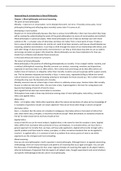Summary
Summary An introduction to moral philosophy. Chapters: 1, 2, 3, 6, 8, 9, 10, 11, 12, 13, 14
- Course
- Institution
- Book
This summary is about the book: An introduction to moral philosophy (2nd edition). The summary contains chapters: 1, 2, 3, 6, 8, 9, 10, 11, 12, 13, 14. This comprehensive summary is written for the Ethics in care and education course of the master orthopedagogy of the RUG.
[Show more]





